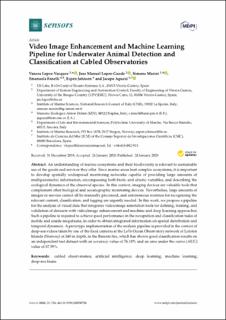| dc.description.abstract | An understanding of marine ecosystems and their biodiversity is relevant to sustainable use of the goods and services they offer. Since marine areas host complex ecosystems, it is important to develop spatially widespread monitoring networks capable of providing large amounts of multiparametric information, encompassing both biotic and abiotic variables, and describing the ecological dynamics of the observed species. In this context, imaging devices are valuable tools that complement other biological and oceanographic monitoring devices. Nevertheless, large amounts of images or movies cannot all be manually processed, and autonomous routines for recognizing the relevant content, classification, and tagging are urgently needed. In this work, we propose a pipeline for the analysis of visual data that integrates video/image annotation tools for defining, training, and validation of datasets with video/image enhancement and machine and deep learning approaches. Such a pipeline is required to achieve good performance in the recognition and classification tasks of mobile and sessile megafauna, in order to obtain integrated information on spatial distribution and temporal dynamics. A prototype implementation of the analysis pipeline is provided in the context of deep-sea videos taken by one of the fixed cameras at the LoVe Ocean Observatory network of Lofoten Islands (Norway) at 260 m depth, in the Barents Sea, which has shown good classification results on an independent test dataset with an accuracy value of 76.18% and an area under the curve (AUC) value of 87.59%. | en_US |
